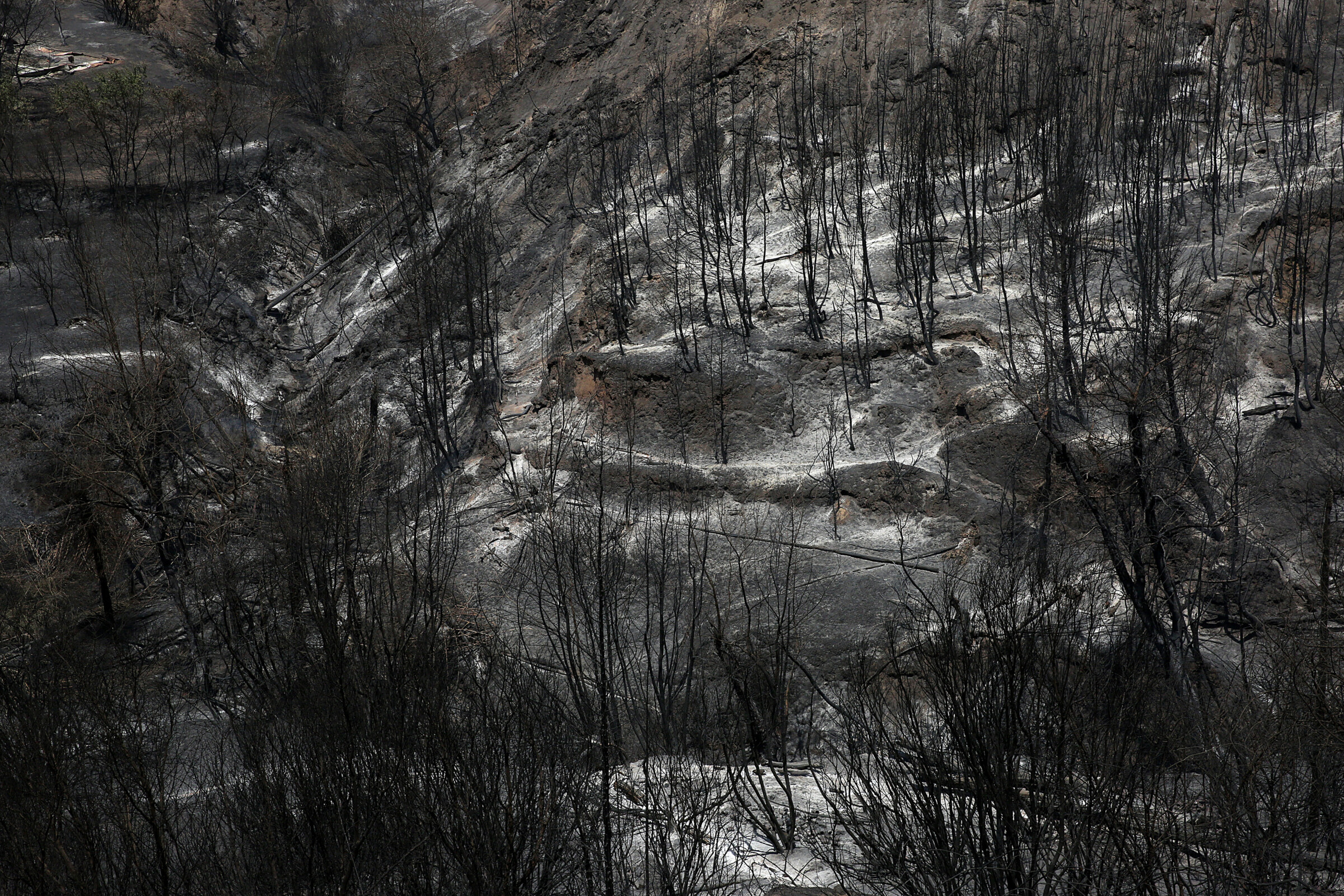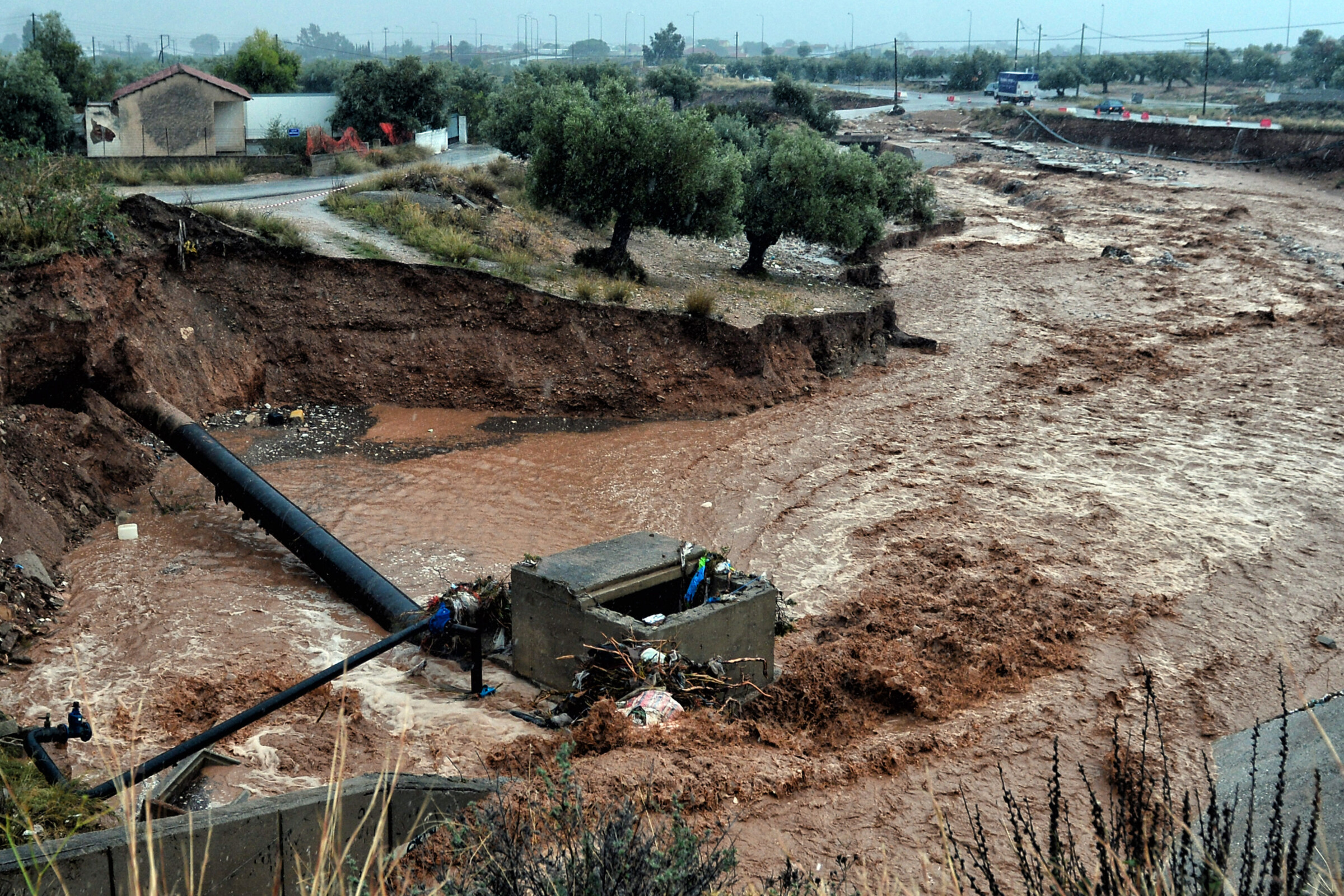Over the past three decades, Greece has witnessed a surge in drought occurrences, heralding potential crop issues, increased flood risks, and a rise in wildfires
This year’s winter rains have brought a vibrant green hue to the windswept island of Tinos. The arrival of spring brought a rare spectacle to the inhabitants, witnessing their island burst into full bloom. But in the searing summer, when the sun scorches everything it touches, the island’s stone becomes incandescent. Amidst this picturesque landscape, Petros Savaris tends to his crops in Kampos, meticulously following the rhythm of the seasons – cultivating artichokes in winter and nurturing tomatoes and zucchini in the warmer months. Yet, with each passing year, the island faces an ominous trend of increasing aridity, leading to a dwindling number of farmers. In response to the “dry” years, Petros has adapted, transitioning to the role of a “stone mason” – a builder who upholds the traditional Tinian methods, centered on the use of stone.
Recollections of the devastating drought that struck Greece in 1989 linger in Petros’ mind. He reflects, “Today, conditions are somewhat improved. Back then, there was neither grass nor vegetation to be found on Tinos. We did have some rain this year, at least enough to sustain the greens.” Since then, thirty years have elapsed, and the country has endured two more droughts of comparable magnitude in 1999 and 2007. This year marked the second consecutive year with meager rainfall, causing great concern for Petros as it poses a potential threat to his crops. Despite a bit of rain in June, it proved insufficient to compensate for the prolonged dry spells of the preceding months.
A drought signifies a prolonged duration of inadequate rainfall, leading to water supply issues and water scarcity. The Cyclades is presently witnessing several drought events, as indicated by the Standardized Precipitation and Evapotranspiration Index (SPEI), which assesses drought based on precipitation and plant evapotranspiration data (i.e., how plants release water from the soil into the atmosphere). Notably, the frequency of these drought occurrences has increased after 2010.
Drought is a complex phenomenon that evolves gradually, with its impacts not immediately evident but potentially destructive. Its multifactorial nature renders it an environmental hazard that proves exceptionally challenging to comprehend, both for the scientific community and the policymakers tasked with its management.
A period of unusually dry weather
Dimitris Tigkas, a PhD student specializing in water resources and drought management at the National Technical University of Athens, emphasizes that Greece is currently facing an extended period of drought, warranting continuous monitoring. When prolonged periods of reduced rainfall coincide with high temperatures, it can result in the extreme phenomenon of drought.
Meanwhile, the situation is even more critical in other parts of Europe. The Rhine in Germany currently stands at a mere 1.5 meters high, the Loire in France has reached such low levels that it can now be crossed on foot, and the receding waters of the Danube are unveiling wrecks from the Second World War. Italy's Po River has plummeted to 3.3 meters below its usual level, exerting immense pressure on the country's agricultural production. Moreover, water supplies in France and Catalonia are steadily dwindling. As meteorologists predict, in 2022, the Old Continent faces the daunting prospect of entering the most severe drought in 500 years.
Greece's climate has always displayed distinct Mediterranean characteristics, setting it apart from the drier African climates or the more humid climates found in central and northern European countries, as noted by Dimitris Tigas. The country lacks large lakes and rivers commonly found across Europe, resulting in limited available water resources. According to a UN report, "most of Greece is either semi-arid or sub-humid according to the UNESCO’s dryness scale, with only the regions west of the Pindos mountains classified as humid, while south-eastern Greece and the islands of Aegean, including Crete, are the driest areas of the country."
Through our analysis of data from the SPEI Global Drought Monitor, a comprehensive database tracking the SPEI index from 1950 to the present day, we have observed that Greece has experienced a minimum of six drought periods since 1990. Simultaneously, the wet periods have become shorter in duration and characterized by lower values.
Researchers commonly categorize drought into four types, each representing different stages and consequences of the phenomenon. The first stage is meteorological drought, which primarily revolves around the absence of rainfall. It is followed by hydrological drought, which concerns the repercussions of reduced rainfall on the availability of surface or underground water sources. Agricultural drought combines elements of meteorological and hydrological drought, focusing on its impact on crops, which can vary in vulnerability based on crop characteristics and regional conditions. The final type is socioeconomic drought, wherein severe water scarcity profoundly affects various sectors of society and the economy, creating significant challenges for communities and policymakers alike.
The risk of desertification
In July 2023, wildfires ravaged West Attica, Rhodes, and Laconia, with soaring temperatures and reduced rainfall identified as primary culprits. "Everything is caught in an escalating cycle," warns Efthymios Lekkas, Professor of Dynamic Tectonic Applied Geology at the University of Athens' Faculty of Geology and Geoenvironment, during an interview. Furthermore, he warns that if this trend continues and with the substantial loss of forests, "the natural environment will no longer be capable of sustaining any natural processes."
Among the most devastating consequences of drought lies the relentless threat of forest fires. Niki Evelpidou, another professor from the University of Athens' Faculty of Geology and Geoenvironment, delves into the link between prolonged drought and increasingly flammable forests. Such conditions played a role in the catastrophic wildfires of August 2021, most notably impacting the Northern part of the island of Evia.

In recent decades, certain regions of Greece, including Attica, the Peloponnese, Crete, and the generally humid Epirus, have witnessed a notable rise in documented drought periods. While some areas may receive a comparable amount of rainfall, the type of rainfall may not be suitable for the soil's requirements. Dimitris Tigas highlights the distinction between intense rainfall, which delivers large amounts of water in a short duration, and "irrigational" rain, which can have a beneficial impact on agriculture.
As Niki Evelpidou points out, the increase in surface runoff is causing a significant escalation in erosion. Although erosion itself may not directly pose a threat to human life like other natural disasters, its consequences can lead to the desertification of an area. The loss of soil takes an extensive amount of time to recover, leading to a decline in vegetation and initiating a vicious cycle that further contributes to the desertification of the environment.

Desertification is a phenomenon exacerbated by the conditions created by drought. Natural processes, such as erosion, lead to the removal of fertile soil components, leaving behind soil with reduced fertility that adversely impacts agricultural production. Human activities, such as improper farming practices and overgrazing, also significantly contribute to desertification.
In July 2023, the world witnessed the highest temperatures ever recorded in history. According to the World Meteorological Organization (WMO) report on the state of Europe's climate in 2022, “The global annual mean temperature in 2022 was around 1.15 ±0.13 °C above the 1850-1900 pre-industrial average, making the last eight years the warmest ever recorded”. Europe stands out as the continent warming at a faster pace compared to other regions studied by the WMO. For Greece, as Dimitris Tigas suggests, this could mean an increase in warmer temperatures and reduced rainfall. Recent days have exemplified this phenomenon, with southern Europe experiencing an intense heatwave.
The World Day to Combat Desertification and Drought on 17 June is a UN observance aimed at raising public awareness of desertification worldwide. The United Nations Convention to Combat Desertification (UNCCD) designates this day to raise awareness among the general public about the critical consequences and developments of land degradation, desertification and drought.
In the last year, two climate-related actions have taken place in which the European Union has played an active role: the United Nations Convention to Combat Deforestation (UNCCD) organized a workshop on the issue on 16 June 2023. Earlier, the International Drought Resilience Alliance was launched in November 2022, within the context of the United Nations Climate Change Conference (COP27) in Egypt. Alliance member states from the African continent, such as Kenya and Somalia, were among the first to face the severe consequences of drought. This year in Europe, it was the turn of Spain and Portugal, whose crops are already facing problems.
In a 2011 report, the National Bank of Greece outlined potential economic consequences of climate change in the country. Specifically, concerning the Cyclades, the report highlighted how the shift from agriculture to tourism, along with changes in the lives of the Cycladic people, has resulted in an increased demand for water that the existing water resources are unable to satisfy. Now, twelve years later, Petros’ firsthand experience confirms the accuracy of the report's predictions. He states, "In 1989, we had wells only a few meters deep, but later we dug an even deeper one and we irrigate from there. The old wells have now dried up."
